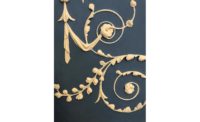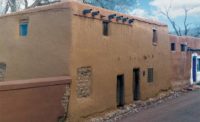The English word, “plaster,” has a rather direct lineage from the Classical Greek emplassein meaning to “mold or form,” as well as the related term emplastron meaning to “daub, to salve.” For the latter term, you can think of plaster as a kind of “makeup” for walls and ceilings. The contemporary English pronunciation has effectively held these ancient words and original meanings more or less intact. The word plaster is still being used to describe a range of materials for casting, coating and beautifying our building.
Typical Plaster Components
Physically plaster begins as a wet, mineral slurry that has a chemical set, reacting with water or what is called a mechanical set, meaning that it simply dries out. The most important component of a plaster is its binder. As the name implies, it’s the component that binds or holds the plaster together. Think of it as a kind of mineral glue. Lime and gypsum are very common traditional binders. Plasters that exclusively use lime or gypsum are commonly referred to as lime plasters or gypsum plasters, respectively. There are other minerals that make can bind such as clay or natural cement and some of them can be used in combination.
Aggregates are typically the ingredient that physically constitutes the bulk of a plaster. Materials such as silica sand act mostly as a relatively inexpensive filler for the binder to cement around. Aside from sand, many other aggregates have been used that impart very distinct and important properties when formulating a plaster. We’ll address several of them in a subsequent essay.
Plaster has to be wet to be ductile, which means spreadable enough to use. The proper level of moisture achieves a good compromise between ductility and stickiness so that the plaster can form a good bond. Potable water is the liquid of choice for plaster more often than others are as it is inexpensive, readily available and safe. Additives can be added to plaster to either accelerate the set or ‘retard’ it, slowing it down. On occasion, loose fibers such as hair, cow dung or even woven fabrics such as burlap are added to the plaster to increase its tensile strength so that it can bend a bit without cracking.
Plaster Names and Types
There is a surprisingly varied range of vocabulary used to describe and subdivide different types of plaster. Many of these are regionally specific and vigorously defended. You might hear terms such as render, coating, grout, mud, dash, harling, parging or daub, to name a few. I’ll describe the three most significant and common designations for plaster that are in widespread use in the United States and Canada.
- Plaster: plaster used as a coating in interiors, for moldings or for ornamental casting
- Stucco: plaster used as a coating in exteriors
- Mortar: plaster used to bond masonry units or rubble
I have definitely heard exceptions to these generalizations here in North America. Some masons would vehemently deny that mortars are plasters whereas others are more accommodating. Stucco describes hand modeling of ornament in some parts. Furthermore, I would say that all of the aforementioned descriptions are practically meaningless throughout the United Kingdom and Europe where local tradition and terminology predominates. Perhaps that is only to be expected in places where folks have had their own way of doing things for centuries.
For thousands of years until as recent as the 19th century, only a small handful of binders, that is to say unique minerals, were used to make plasters, stuccoes and mortars: clay, gypsum and an entire family of limes. In my next blog, I’ll introduce these amazing “mineral glues” including an overview of the physical properties that make them so special and useful for plasters.








Report Abusive Comment